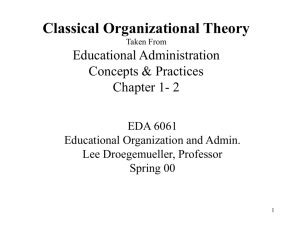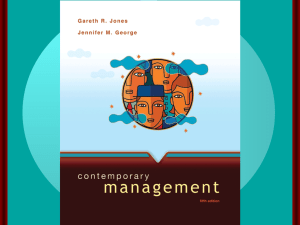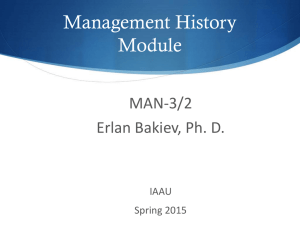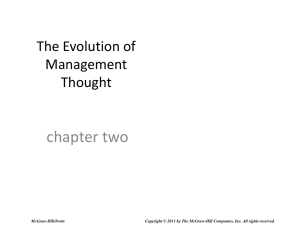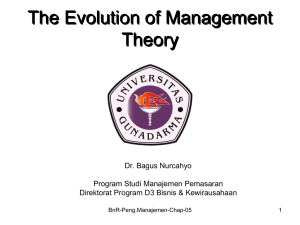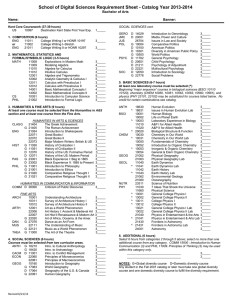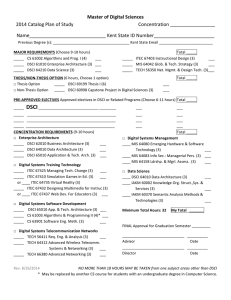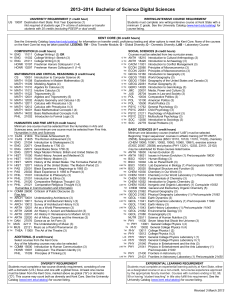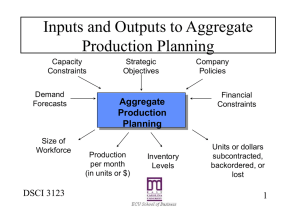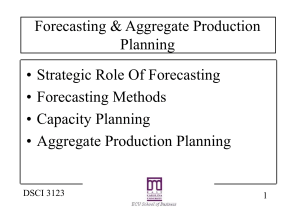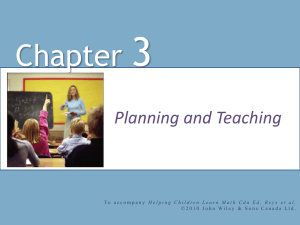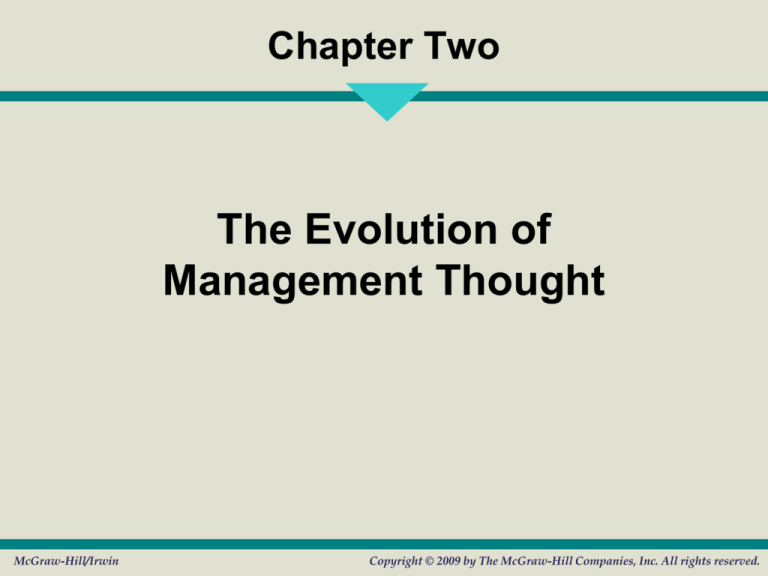
Chapter Two
The Evolution of
Management Thought
McGraw-Hill/Irwin
Copyright © 2009 by The McGraw-Hill Companies, Inc. All rights reserved.
The Evolution of Management Theory
Figure 2.1
2-2
Job Specialization and
the Division of Labor
Job Specialization
≈ process by which a division of labor occurs as
different workers specialize in specific tasks
over time
Adam Smith (18th century economist)
concluded that increasing the level of job
specialization increases efficiency and
leads to greater org performance
2-3
F.W. Taylor and Scientific Management
Scientific Management
≈ The systematic study of the relationships between
people and tasks for the purpose of redesigning
the work process to increase efficiency.
1. Study way workers perform tasks (time-and-motion
study), gather informal job knowledge, experiment w/
ways of improving how tasks performed
2. Codify new methods into SOPs
3. Carefully select workers possessing skills/abilities that
match needs of task, train them to perform task
according to SOPs
4. Establish acceptable performance level for task,
develop pay system providing reward beyond
acceptable level
2-4
Problems with Scientific Management
Managers frequently implemented only the
increased output side of Taylor’s plan.
≈ Workers did not share in the increased output.
Specialized jobs became very boring, dull.
≈ Workers ended up distrusting the Scientific
Management method.
2-5
Administrative Management Theory
Administrative Management
≈ The study of how to create an organizational
structure that leads to high efficiency and
effectiveness.
2-6
Weber’s Principles of Bureaucracy
Figure 2.2
2-7
Fayol’s Principles of Management
Division of Labor: allows for job specialization
(provided boredom is managed, e.g., job
enlargement/enrichment)
Authority and Responsibility (both formal and
informal)
Unity of Command: one supervisor
Line of Authority: limited length to chain of
command
Centralization: authority should not be
concentrated at top of chain of command???
Unity of Direction: single plan of action
Equity: justice and respect
2-8
Fayol’s Principles of Management
Order: maximize org efficiency, provide ees w/
satisfying career opportunities
Initiative: allow ees to be innovative
Discipline: focused
Remuneration of Personnel: equitable
Stability of Tenure of Personnel
Subordination of Individual Interest to the
Common Interest
Esprit de corps (org culture)
2-9
Behavioral Management Theory
Behavioral Management
≈ The study of how managers should personally
behave to motivate employees and encourage
them to perform at high levels and be
committed to the achievement of organizational
goals.
2-10
Behavioral Management
Mary Parker Follett
≈ Concerned that Taylor ignored the human side
of the organization
Suggested workers help in analyzing their jobs
If workers have relevant knowledge of the task, then
they should control the task
2-11
The Hawthorne Studies
Studies of how characteristics of the work
setting affected worker fatigue and
performance at the Hawthorne Works of the
Western Electric Company from 1924-1932.
≈ Worker productivity was measured at various
levels of light illumination.
Hawthorne effect — workers’ attitudes
toward their managers affect the level of
workers’ performance
2-12
Behavioral Management
Human relations movement
≈ advocates that supervisors be behaviorally
trained to manage subordinates in ways that
elicit their cooperation and increase their
productivity
Organizational Behavior
≈ MNGT 315
2-13
Theory X vs. Theory Y
Figure 2.3
2-14
Management Science Theory
Management Science Theory
≈ Contemporary approach to management that
focuses on the use of rigorous quantitative
techniques to help managers make maximum
use of organizational resources to produce
goods and services.
2-15
Management Science Theory
Quantitative management
≈ utilizes mathematical techniques, like linear
programming, modeling, simulation and chaos
theory
≈ DSCI 351
Operations management
≈ provides managers a set of techniques they can
use to analyze any aspect of an organization’s
production system to increase efficiency
≈ DSCI 445
2-16
Management Science Theory
Total quality management
≈ focuses on analyzing an organization’s input,
conversion, and output activities to increase
product quality
≈ DSCI 446
Management information systems
≈ help managers design systems that provide
information that is vital for effective decision
making
≈ CIS 305
≈ ACCT 413
2-17
Organizational Environment Theory
Organizational Environment
≈ The set of forces and conditions that operate
beyond an organization’s boundaries but affect
a manager’s ability to acquire and utilize
resources
≈ MNGT 443
2-18
The Organization as an Open System
Figure 2.4
2-19
Contingency Theory
Figure 2.5
2-20
Type of Structure
Mechanistic Structure
≈Authority is centralized at the top.
≈Emphasis is on strict discipline and order.
≈Employees are closely monitored and
managed.
≈Can be very efficient in a stable
environment.
2-21
Type of Structure
Organic Structure
≈ Authority is decentralized throughout the
organization.
≈ Departments are encouraged to take a crossdepartmental or functional perspective.
≈ Works best when environment is unstable and
rapidly changing.
2-22
Case Study: Flight 3407
Continental Connection Flight 3407 crashed in Buffalo, NY 2/12/09,
killing all 49 people on board as well as one on ground
≈ Operated by Colgan Inc., unit of Pinnacle Airlines
Captain 47 yrs old, co-pilot 24 yrs old
≈ FAA safety inspector assigned to Colgan testified that pilots frequently
violated safety rules by engaging in idle chatter in cockpit
Part of culture: “you can kind of slide by, cut corners, wink and nod when the FAA is
not there.”
≈ Colgan previously failed to maintain detailed records of pilots who failed
proficiency tests
Determined after crash that captain failed five flight tests over period of five years
Q: How to manage airline so as to minimize risk of accidents?
≈ Since accident Colgan has instituted numerous changes, including
enhanced stall-recovery training, new operations manual, stricter
experience requirements for new hires
Source: Wall Street Journal, 5/13/09
2-23

